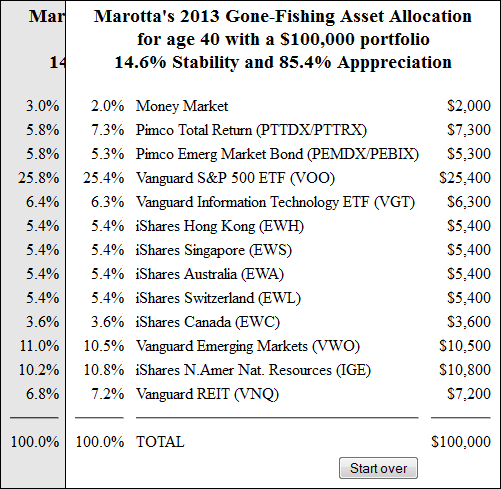
This post has been update by Marotta’s 2014 Gone-Fishing Portfolio.
A gone-fishing portfolio has a limited number of investments with a balanced asset allocation that should do well with dampened volatility. Its primary appeal is simplicity. As a secondary virtue, it avoids the worst mistakes of the financial services industry. This year uses the exact same 12 investment vehicles as last year.
Asset allocation begins by selecting the top six asset categories. A good starting point is an age-appropriate allocation. We use as our example a couple both born in 1973 and turning 40 this year. The most popular names of that era were Michael and Jennifer. Their age-appropriate allocation will be 2% short money, 7.3% U.S. bonds, 5.3% foreign bonds, 31.7% U.S. stocks, 35.7% foreign stocks and 18.0% hard asset stocks.
I’ve adjusted the mix slightly from 2012 to 2013. Last year I allocated 0%, 3% or 5% to short money. This year it is more accurately tuned to safe withdrawal rates. I increase the allocation to resource stocks (also called hard asset stocks) by 1%. And I’ve tilted the bond mix slightly toward the US.
Here is Michael and Jennifer’s portfolio mix for 2013 (with last year’s mix from 2012 in the background):

Read last year’s gone fishing post for a greater understanding of these choices.
A new age and portfolio value calculator can be found on our website at: http://www.marottaonmoney.com/gone-fishing-2013/.
A gone-fishing portfolio is appropriate for limited amounts of money, especially during the accumulation phase. When investors have significant holdings or approach retirement, I recommend seeking professional comprehensive financial planning from a fee-only fiduciary.
![]() This article is one of our most popular posts.
This article is one of our most popular posts.